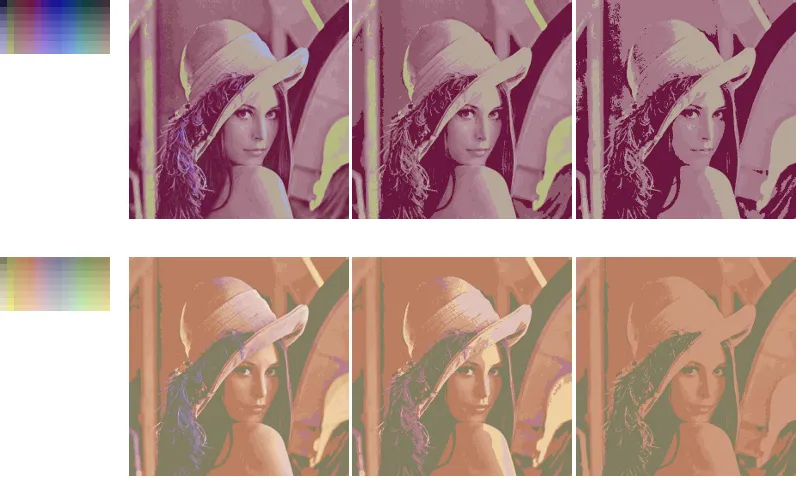概览
这是解决问题的一种可能方法:
1)将输入像素中的每个颜色映射到输入调色板中最接近的颜色。
2)如果生成的调色板大于允许的最大颜色数量,则通过从计算出的调色板中删除彼此最相似的颜色来将调色板减少到最大允许数量(我选择了最近距离进行删除,因此结果图像保持高对比度)。
3)如果生成的调色板小于允许的最大颜色数量,则使用剩余输入调色板中最相似的颜色填充调色板,直到达到允许的颜色数量。希望dithering算法在dithering期间可以利用这些颜色。请注意,我没有看到用Floyd-Steinberg算法填充或不填充调色板之间有太大的区别...
4)作为最后一步,输入像素使用计算得出的调色板进行dithering。
实现
以下是该方法的实现。
如果要运行源代码,则需要这个类:ImageFrame.java。您可以将输入图像设置为唯一的程序参数,所有其他参数必须在main方法中设置。使用的Floyd-Steinberg算法来自Floyd-Steinberg dithering。
可以在调色板减少算法中选择3种不同的减少策略:
1)ORIGINAL_COLORS:此算法尝试尽可能忠实于输入像素颜色,方法是搜索调色板中距离最小的两种颜色。从这两种颜色中删除映射到输入映射中像素最少的那个颜色。
2)BETTER_CONTRAST:与ORIGINAL_COLORS相同,不同之处在于它从两种颜色中删除平均距离到其余调色板的最低值的颜色。
3)AVERAGE_DISTANCE:该算法始终从池中删除平均距离最小的颜色。对于灰度调色板,此设置特别可以提高生成图像的质量。
以下是完整代码:
import java.awt.Color;
import java.awt.Image;
import java.awt.image.PixelGrabber;
import java.io.File;
import java.io.IOException;
import java.util.ArrayList;
import java.util.HashMap;
import java.util.HashSet;
import java.util.List;
import java.util.Map;
import java.util.Random;
import java.util.Set;
public class Quantize {
public static class RGBTriple {
public final int[] channels;
public RGBTriple() { channels = new int[3]; }
public RGBTriple(int color) {
int r = (color >> 16) & 0xFF;
int g = (color >> 8) & 0xFF;
int b = (color >> 0) & 0xFF;
channels = new int[]{(int)r, (int)g, (int)b};
}
public RGBTriple(int R, int G, int B)
{ channels = new int[]{(int)R, (int)G, (int)B}; }
}
public static class FloydSteinbergDither
{
private static int plus_truncate_uchar(int a, int b) {
if ((a & 0xff) + b < 0)
return 0;
else if ((a & 0xff) + b > 255)
return (int)255;
else
return (int)(a + b);
}
private static int findNearestColor(RGBTriple color, RGBTriple[] palette) {
int minDistanceSquared = 255*255 + 255*255 + 255*255 + 1;
int bestIndex = 0;
for (int i = 0; i < palette.length; i++) {
int Rdiff = (color.channels[0] & 0xff) - (palette[i].channels[0] & 0xff);
int Gdiff = (color.channels[1] & 0xff) - (palette[i].channels[1] & 0xff);
int Bdiff = (color.channels[2] & 0xff) - (palette[i].channels[2] & 0xff);
int distanceSquared = Rdiff*Rdiff + Gdiff*Gdiff + Bdiff*Bdiff;
if (distanceSquared < minDistanceSquared) {
minDistanceSquared = distanceSquared;
bestIndex = i;
}
}
return bestIndex;
}
public static int[][] floydSteinbergDither(RGBTriple[][] image, RGBTriple[] palette)
{
int[][] result = new int[image.length][image[0].length];
for (int y = 0; y < image.length; y++) {
for (int x = 0; x < image[y].length; x++) {
RGBTriple currentPixel = image[y][x];
int index = findNearestColor(currentPixel, palette);
result[y][x] = index;
for (int i = 0; i < 3; i++)
{
int error = (currentPixel.channels[i] & 0xff) - (palette[index].channels[i] & 0xff);
if (x + 1 < image[0].length) {
image[y+0][x+1].channels[i] =
plus_truncate_uchar(image[y+0][x+1].channels[i], (error*7) >> 4);
}
if (y + 1 < image.length) {
if (x - 1 > 0) {
image[y+1][x-1].channels[i] =
plus_truncate_uchar(image[y+1][x-1].channels[i], (error*3) >> 4);
}
image[y+1][x+0].channels[i] =
plus_truncate_uchar(image[y+1][x+0].channels[i], (error*5) >> 4);
if (x + 1 < image[0].length) {
image[y+1][x+1].channels[i] =
plus_truncate_uchar(image[y+1][x+1].channels[i], (error*1) >> 4);
}
}
}
}
}
return result;
}
public static void generateDither(int[] pixels, int[] p, int w, int h){
RGBTriple[] palette = new RGBTriple[p.length];
for (int i = 0; i < palette.length; i++) {
int color = p[i];
palette[i] = new RGBTriple(color);
}
RGBTriple[][] image = new RGBTriple[w][h];
for (int x = w; x-- > 0; ) {
for (int y = h; y-- > 0; ) {
int index = y * w + x;
int color = pixels[index];
image[x][y] = new RGBTriple(color);
}
}
int[][] result = floydSteinbergDither(image, palette);
convert(result, pixels, p, w, h);
}
public static void convert(int[][] result, int[] pixels, int[] p, int w, int h){
for (int x = w; x-- > 0; ) {
for (int y = h; y-- > 0; ) {
int index = y * w + x;
int index2 = result[x][y];
pixels[index] = p[index2];
}
}
}
}
private static class PaletteColor{
final int color;
public PaletteColor(int color) {
super();
this.color = color;
}
@Override
public int hashCode() {
final int prime = 31;
int result = 1;
result = prime * result + color;
return result;
}
@Override
public boolean equals(Object obj) {
if (this == obj)
return true;
if (obj == null)
return false;
if (getClass() != obj.getClass())
return false;
PaletteColor other = (PaletteColor) obj;
if (color != other.color)
return false;
return true;
}
public List<Integer> indices = new ArrayList<>();
}
public static int[] getPixels(Image image) throws IOException {
int w = image.getWidth(null);
int h = image.getHeight(null);
int pix[] = new int[w * h];
PixelGrabber grabber = new PixelGrabber(image, 0, 0, w, h, pix, 0, w);
try {
if (grabber.grabPixels() != true) {
throw new IOException("Grabber returned false: " +
grabber.status());
}
} catch (InterruptedException e) {
e.printStackTrace();
}
return pix;
}
public static float getPixelDistance(PaletteColor color1, PaletteColor color2){
int c1 = color1.color;
int r1 = (c1 >> 16) & 0xFF;
int g1 = (c1 >> 8) & 0xFF;
int b1 = (c1 >> 0) & 0xFF;
int c2 = color2.color;
int r2 = (c2 >> 16) & 0xFF;
int g2 = (c2 >> 8) & 0xFF;
int b2 = (c2 >> 0) & 0xFF;
return (float) getPixelDistance(r1, g1, b1, r2, g2, b2);
}
public static double getPixelDistance(int r1, int g1, int b1, int r2, int g2, int b2){
return Math.sqrt(Math.pow(r2 - r1, 2) + Math.pow(g2 - g1, 2) + Math.pow(b2 - b1, 2));
}
public static void fillPalette(List<PaletteColor> fillColors, List<PaletteColor> colors, int max_cols){
while (fillColors.size() < max_cols) {
int index = -1;
float minDistance = -1;
for (int i = 0; i < fillColors.size(); i++) {
PaletteColor color1 = colors.get(i);
for (int j = 0; j < colors.size(); j++) {
PaletteColor color2 = colors.get(j);
if (color1 == color2) {
continue;
}
float distance = getPixelDistance(color1, color2);
if (index == -1 || distance < minDistance) {
index = j;
minDistance = distance;
}
}
}
PaletteColor color = colors.get(index);
fillColors.add(color);
}
}
public static void reducePaletteByAverageDistance(List<PaletteColor> colors, int max_cols, ReductionStrategy reductionStrategy){
while (colors.size() > max_cols) {
int index = -1;
float minDistance = -1;
for (int i = 0; i < colors.size(); i++) {
PaletteColor color1 = colors.get(i);
float averageDistance = 0;
int count = 0;
for (int j = 0; j < colors.size(); j++) {
PaletteColor color2 = colors.get(j);
if (color1 == color2) {
continue;
}
averageDistance += getPixelDistance(color1, color2);
count++;
}
averageDistance/=count;
if (minDistance == -1 || averageDistance < minDistance) {
minDistance = averageDistance;
index = i;
}
}
PaletteColor removed = colors.remove(index);
PaletteColor best = null;
minDistance = -1;
for (int i = 0; i < colors.size(); i++) {
PaletteColor c = colors.get(i);
float distance = getPixelDistance(c, removed);
if (best == null || distance < minDistance) {
best = c;
minDistance = distance;
}
}
best.indices.addAll(removed.indices);
}
}
public static void reducePalette(List<PaletteColor> colors, int max_cols, ReductionStrategy reductionStrategy){
if (reductionStrategy == ReductionStrategy.AVERAGE_DISTANCE) {
reducePaletteByAverageDistance(colors, max_cols, reductionStrategy);
return;
}
while (colors.size() > max_cols) {
int index1 = -1;
int index2 = -1;
float minDistance = -1;
for (int i = 0; i < colors.size(); i++) {
PaletteColor color1 = colors.get(i);
for (int j = i+1; j < colors.size(); j++) {
PaletteColor color2 = colors.get(j);
if (color1 == color2) {
continue;
}
float distance = getPixelDistance(color1, color2);
if (index1 == -1 || distance < minDistance) {
index1 = i;
index2 = j;
minDistance = distance;
}
}
}
PaletteColor color1 = colors.get(index1);
PaletteColor color2 = colors.get(index2);
switch (reductionStrategy) {
case BETTER_CONTRAST:
int count = 0;
float distance1 = 0;
float distance2 = 0;
for (PaletteColor c : colors) {
if (c != color1 && c != color2) {
count++;
distance1 += getPixelDistance(color1, c);
distance2 += getPixelDistance(color2, c);
}
}
if (count != 0 && distance1 != distance2) {
distance1 /= (float)count;
distance2 /= (float)count;
if (distance1 < distance2) {
colors.remove(index1);
color2.indices.addAll(color1.indices);
} else{
colors.remove(index2);
color1.indices.addAll(color2.indices);
}
break;
}
default:
if (color1.indices.size() < color2.indices.size()) {
colors.remove(index1);
color2.indices.addAll(color1.indices);
} else{
colors.remove(index2);
color1.indices.addAll(color2.indices);
}
break;
}
}
}
public static List<PaletteColor> createInitialPalette(int pixels[], int[] palette){
Map<Integer, Integer> used = new HashMap<>();
ArrayList<PaletteColor> result = new ArrayList<>();
for (int i = 0, l = pixels.length; i < l; i++) {
double bestDistance = Double.MAX_VALUE;
int bestIndex = -1;
int pixel = pixels[i];
int r1 = (pixel >> 16) & 0xFF;
int g1 = (pixel >> 8) & 0xFF;
int b1 = (pixel >> 0) & 0xFF;
for (int k = 0; k < palette.length; k++) {
int pixel2 = palette[k];
int r2 = (pixel2 >> 16) & 0xFF;
int g2 = (pixel2 >> 8) & 0xFF;
int b2 = (pixel2 >> 0) & 0xFF;
double dist = getPixelDistance(r1, g1, b1, r2, g2, b2);
if (dist < bestDistance) {
bestDistance = dist;
bestIndex = k;
}
}
Integer index = used.get(bestIndex);
PaletteColor c;
if (index == null) {
index = result.size();
c = new PaletteColor(palette[bestIndex]);
result.add(c);
used.put(bestIndex, index);
} else{
c = result.get(index);
}
c.indices.add(i);
}
return result;
}
public static int[] createRandomColorPalette(int num_colors){
Random random = new Random(101);
int count = 0;
int[] result = new int[num_colors];
float add = 360f / (float)num_colors;
for(float i = 0; i < 360f && count < num_colors; i += add) {
float hue = i;
float saturation = 90 +random.nextFloat() * 10;
float brightness = 50 + random.nextFloat() * 10;
result[count++] = Color.HSBtoRGB(hue, saturation, brightness);
}
return result;
}
public static int[] createGrayScalePalette(int count){
float[] grays = new float[count];
float step = 1f/(float)count;
grays[0] = 0;
for (int i = 1; i < count-1; i++) {
grays[i]=i*step;
}
grays[count-1]=1;
return createGrayScalePalette(grays);
}
public static int[] createGrayScalePalette(float[] grays){
int[] result = new int[grays.length];
for (int i = 0; i < result.length; i++) {
float f = grays[i];
result[i] = Color.HSBtoRGB(0, 0, f);
}
return result;
}
private static int[] createResultingImage(int[] pixels,List<PaletteColor> paletteColors, boolean dither, int w, int h) {
int[] palette = new int[paletteColors.size()];
for (int i = 0; i < palette.length; i++) {
palette[i] = paletteColors.get(i).color;
}
if (!dither) {
for (PaletteColor c : paletteColors) {
for (int i : c.indices) {
pixels[i] = c.color;
}
}
} else{
FloydSteinbergDither.generateDither(pixels, palette, w, h);
}
return palette;
}
public static int[] quantize(int[] pixels, int widht, int heigth, int[] colorPalette, int max_cols, boolean dither, ReductionStrategy reductionStrategy) {
List<PaletteColor> paletteColors = createInitialPalette(pixels, colorPalette);
reducePalette(paletteColors, max_cols, reductionStrategy);
assert paletteColors.size() <= max_cols;
if (paletteColors.size() < max_cols) {
List<PaletteColor> remainingColors = new ArrayList<>();
Set<PaletteColor> used = new HashSet<>(paletteColors);
for (int i = 0; i < colorPalette.length; i++) {
int color = colorPalette[i];
PaletteColor c = new PaletteColor(color);
if (!used.contains(c)) {
remainingColors.add(c);
}
}
fillPalette(paletteColors, remainingColors, max_cols);
}
assert paletteColors.size() == max_cols;
return createResultingImage(pixels,paletteColors, dither, widht, heigth);
}
static enum ReductionStrategy{
ORIGINAL_COLORS,
BETTER_CONTRAST,
AVERAGE_DISTANCE,
}
public static void main(String args[]) throws IOException {
String imageFileName = args[0];
File file = new File(imageFileName);
boolean dither = true;
int colorPaletteSize = 80;
int max_cols = 3;
max_cols = Math.min(max_cols, colorPaletteSize);
int[] colorPalette = createGrayScalePalette(20);
ReductionStrategy reductionStrategy = ReductionStrategy.AVERAGE_DISTANCE;
ImageFrame original = new ImageFrame();
original.setImage(file);
original.setTitle("Original Image");
original.setLocation(0, 0);
Image image = original.getImage();
int width = image.getWidth(null);
int heigth = image.getHeight(null);
int pixels[] = getPixels(image);
int[] palette = quantize(pixels, width, heigth, colorPalette, max_cols, dither, reductionStrategy);
ImageFrame reduced = new ImageFrame();
reduced.setImage(width, heigth, pixels);
reduced.setTitle("Quantized Image (" + palette.length + " colors, dither: " + dither + ")");
reduced.setLocation(100, 100);
}
}
可能的改进
1)目前使用的Floyd-Steinberg算法仅适用于最多具有256种颜色的调色板。我想这可能很容易修复,但由于目前使用的FloydSteinbergDither类需要相当多的转换,因此最好从头实现算法,以便其适合最后使用的颜色模型。
2)我认为像scolorq这样使用另一种抖动算法可能更好。在他们主页的“待办事项”清单中,他们写道:
[待办:]将一些颜色固定为预定集(该算法支持但当前未实现)的能力
因此,似乎可以对算法使用固定的调色板。Photoshop/Gimp插件Ximagic似乎使用scolorq实现了这个功能。从他们的首页上:
Ximagic Quantizer是用于图像颜色量化(颜色减少)和抖动的Photoshop插件。
提供:预定义的调色板量化
3)填充调色板的算法可能需要改进 - 例如通过使用平均距离(如在减少算法中)来填充调色板。但这应该根据最终使用的抖动算法进行测试。

